|
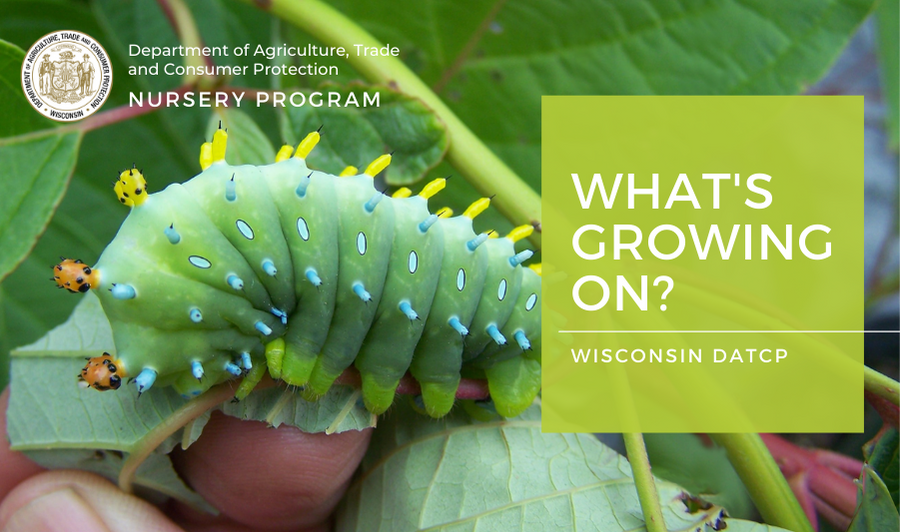 _____________________________________
Dear Wisconsin nurseries, Christmas tree growers, and gardeners:
As our spring weather stabilizes, growing degree days (GDD) (simple B50) as of May 14th were 122 in Bayfield, 163 in Medford and Wausau, 194 in Hancock and Green Bay, 206 in Racine, 249 in Madison, and 278 in La Crosse. A few pests and diseases in a vulnerable-to-treatment stage (200-350 DDB50) include fletcher scale, spongy moth, pine needle scale and rhizosphaera needle cast.
Take a moment to read through a few updates from the DATCP nursery and other Plant Protection programs. Please send any feedback, questions, or ideas for future e-news updates to datcpnursery@wisconsin.gov.
Having trouble viewing this email? View it as a Web page.
_____________________________________
|
|
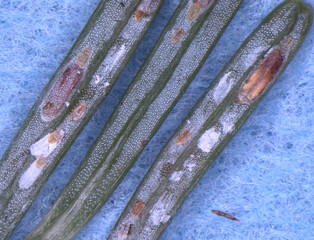
DATCP’s proposed permanent rule changes to ATCP 21 (AKA Clearinghouse Rule CR 22-022), relating to Plant Inspection and Pest Control will become effective 07/01/2023, after the final rule draft, certified by Sec. Romanski 04/26/23, is published in the June B Administrative Register. (image left: EHS male and female nymph stages, DATCP) This permanent rule change, which has been in the works since 2020, rescinds quarantines for pine shoot beetle (ATCP 21.12), emerald ash borer (ATCP 21.17), and thousand cankers disease (ATCP 21.21), due to lack of serious pest impacts, the quarantine outliving its ability to contain the pest, federal deregulation, or a combination of factors. The rule change also revises quarantines for hemlock woolly adelgid (ATCP 21.16) and Phytophthora ramorum (ATCP 21.19) to ensure that the infested area, host range, and regulated articles reflect best available science, current pest distribution, and host associations. Finally, this rule change also creates a new exterior quarantine for elongate hemlock scale (EHS) in WI (which will be known as ATCP 21.23), the only specific regulation for this pest in the US. Rationale for quarantining EHS included the dozens of times inspectors have intercepted it on cut fir Christmas trees, fir wreaths, and hemlock nursery stock from out-of-state, coupled with the fact that EHS is not established in Wisconsin. Other reasons for the regulation are that EHS is hard to control with pesticides and because it poses serious threats to the Christmas tree industry and our unique, native hemlock and balsam fir forests in Wisconsin.
Over the coming weeks, staff will develop a compliance agreement for the new EHS quarantine, update our regulatory summary on the National Plant Board website, and reach out to nursery growers, Christmas tree dealers, wreathmakers and others who import hemlock and fir (the favorite hosts of EHS) from the infested area, which includes many eastern states (CT, DE, GA, KY, ME, MD, MA, MI, NH, NJ, NY, NC, OH, PA, RI, SC, TN, VT, VA, WV) to make sure they understand and know how to follow the new regulation. We are hopeful that permanent changes to ATCP 21 will protect native forests and our green industry from invasive pests like EHS for years to come, and remove other outdated regulations. Please contact shahla.werner@wisconsin.gov with questions about the new rule or to inquire about getting an EHS compliance agreement (which provides a limited exemption to a quarantine provided that risk reduction measures are taken) for your business.
|
_____________________________________
|
|
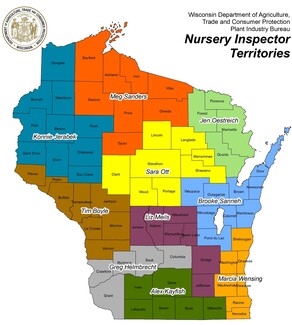
We have had a number of changes since the last growing season. Three of our nursery inspectors left for other job opportunities (Tim Allen, Emma Graves and Shanon Hankin). With those vacancies we took some time to reevaluate workloads and nursery territories. Each territory comes with unique businesses and demands. Many of our inspectors also coordinate a variety of statewide programs to help facilitate the inspection and certification for the movement of Wisconsin's many different plant products. In order to best meet those needs we now welcome three new inspectors (Alex Kayfish, Georgia Meysembourg and Meg Sanders). Please also note that while territories remained largely the same, a few counties were shifted to a neighboring territory.
Nursery Inspectors look for regulated or invasive pests and diseases, and provide a report of general pests, diseases and invasive species found during the inspection. Inspectors can provide additional information on management of pests and cultural problems, when requested.
|
_____________________________________
|
|
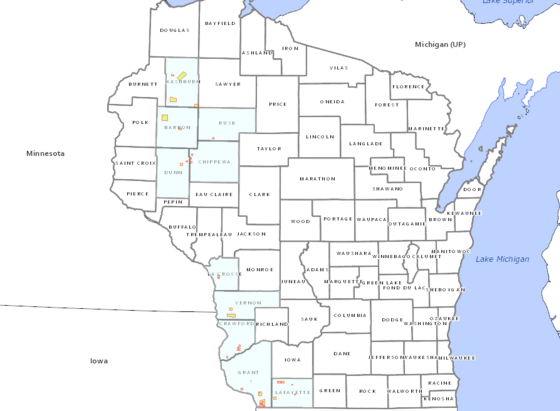 2023 Aerial Spray Map for Spongy Moth | DATCP image
This spring DATCP plans to treat select areas in 10 western Wisconsin counties for spongy moth (Lymantria dispar). Spray operations start shortly after caterpillars hatch, depending on favorable weather. The aerial treatments DATCP will be conducting are the most efficient and effective method to delay the impacts associated with spongy moth outbreaks, including the cost of removing dead trees, potential loss of property value and irritation to the eyes, skin and respiratory system in some humans caused by the shed skins of the caterpillars. Residents in and near treatment sites can expect to see and hear loud, low-flying planes as early as sunrise.
From Mid-May to early June, the planes will spray Bacillus thuringiensis var. kurstaki (Btk), which is a naturally-occurring soil bacteria that kills spongy moth caterpillars feeding on canopy foliage. Btk is not toxic to people, bees, pets, or other animals and is also used in certified organic food production. It's looking like spray will begin late this week, possibly as early as May 18, provided that the weather cooperates. The following counties are scheduled to receive Btk treatments: Chippewa, Crawford, Dunn, Grant, La Crosse, Lafayette, and Rusk.
In late June to mid-July, planes will spray an organic, biodegradable mating disruptant containing spongy moth pheromone. Pheromone treatments target adult male moths by inhibiting their ability to locate female moths. The following counties are scheduled to receive mating disruptant: Barron, Chippewa, Crawford, Dunn, Grant, La Crosse, Lafayette, Vernon and Washburn.
Treatments will begin in southern Wisconsin in May and end in northern Wisconsin in mid-July. Maps of treatment areas are available at https://smaerialspray.wi.gov. To receive up-to-date information on treatment plans:
- Sign up for email updates.
- Call the hotline toll-free at (800) 642-MOTH.
- Email questions to spongymoth@wisconsin.gov.
_____________________________________
|
|
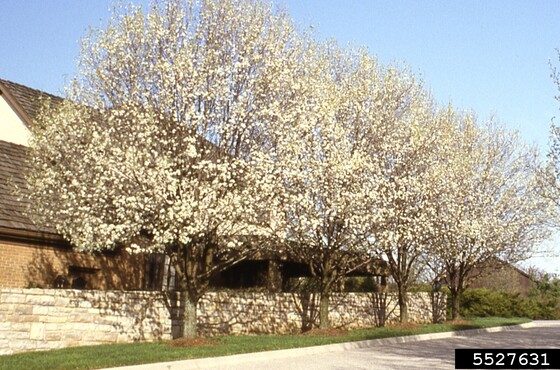 Callery pear (Bradford pear) (Pyrus calleryana) planted along a road | T. Davis Sydnor, The Ohio State University, Bugwood.org
As shipping season is underway, this is a reminder to review the laws and regulations regarding plant sales for all the states you intend to purchase from, and ship into. You can review plant law summaries for each state on the National Plant Board’s website (nationalplantboard.org). If you don’t see a recent update on this list for a particular state, contact that state directly. You will also want to check for new plants being added to the lists of regulated invasive species in states you plan to ship to, since each state maintains their own lists of plants regulated as invasive to their state. The Midwest Invasive Plant Network maintains a helpful table listing invasive plants by state on their website (mipm.org).
For nurseries shipping to Minnesota, note they have several ornamental plants on their Noxious Weeds list in different categories. Winged burning bush and all cultivars (Euonymus alatus) are “Specially Regulated” as Noxious Weeds and can no longer be transported or sold as of 2023. Siberian Pea Shrub and all cultivars (Caragana arborescens) is listed under “Restrictive Noxious Weeds” with one exemption for Green Spires Caragana (Caragana ‘Jefarb’). These plants were added to Minnesota’s Noxious Weed Law in 2020 with a three-year phase-out which ends in 2023. Additional “Specially Regulated” plants include Amur maple (Acer ginnala) and Norway maple and all cultivars (Acer platanoides). These plants are required to have specific cautions attached to each label. The rule states, “Sellers shall affix a label directly to the plant or container packaging that is being sold that advises buyers to only plant Amur Maple and its cultivars in landscapes where the seedlings will be controlled by mowing or other means. Amur Maple seed is wind dispersed and trees should be planted at least 100 yards from natural areas.” (For Norway maples use same wording, substituting ‘Norway’ for ‘Amur’). If your WI nursery is shipping these plants into MN be sure your labels have this information attached to each plant.
Please note that Callery Pear was recently designated as a Specially Regulated Invasive Plant in January 2023. They will allow a 3 year phase out. In 2026, Callery Pear will be Restricted and not able to be sold in Minnesota. As of January 2023 Ohio has also added Callery Pear to their list of regulated invasive plants and it is now illegal to be sold in Ohio.
These are just a few updates on invasive plant laws. It is the responsibility of each nursery, whether you’re buying stock in, shipping it out, or both, to familiarize yourself with the plant laws in the states where you do business.
_____________________________________
|
|
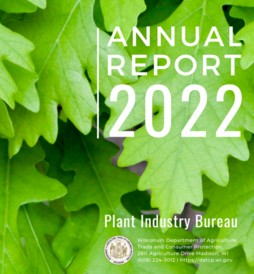
The DATCP Nursery Program is housed in the Bureau of Plant Industry. This bureau protects Wisconsin's agricultural and horticultural interests by overseeing and ensuring compliance with laws and regulations involving plant pests, honey bees, nursery plants, Christmas trees, firewood, and seed. The bureau carries out control or eradication programs designed to prevent the spread of harmful pests. These programs include inspection, certification, quarantine, and survey activities.
The bureau also facilitates interstate and international commerce of agricultural products and commodities by certifying plant health and the pest-free status of Wisconsin exports. The bureau annual report, published each April, outlines the regulatory and survey activities conducted over the past year to protect Wisconsin's agriculture, forests, and green industry from insects and diseases that pose an economic and environmental threat.
|
_____________________________________
|
|
|
|
|